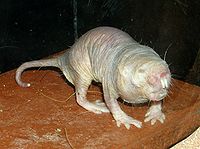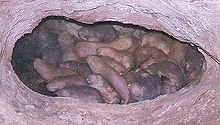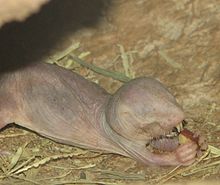- Naked mole rat
-
Naked mole rat
Temporal range: Early Pliocene - Recent
Conservation status Scientific classification 
Kingdom: Animalia Phylum: Chordata Class: Mammalia Order: Rodentia Family: Bathyergidae Subfamily: Heterocephalinae
Landry, 1957Genus: Heterocephalus
Rüppell, 1842Species: H. glaber Binomial name Heterocephalus glaber
Rüppell, 1842
Distribution of the Naked Mole Rat The naked mole rat (Heterocephalus glaber), also known as the sand puppy or desert mole rat, is a burrowing rodent native to parts of East Africa and the only species currently classified in the genus Heterocephalus. It is one of only two known eusocial mammals (the other being the Damaraland mole rat) and has a highly unusual set of physical traits that enables it to thrive in an otherwise harsh, underground environment, including a lack of pain sensation in its skin and a very low metabolism.
Contents
Physical description
Typical individuals are 8 to 10 cm (3 to 4 in) long and weigh 30 to 35 grams (1.1 to 1.2 oz). Queens are larger and may weigh well over 50 grams (1.8 oz), the largest reaching 80 grams (2.8 oz). They are well-adapted to their underground existence. Their eyes are quite small, and their visual acuity is poor. Their legs are thin and short; however, they are highly adept at moving underground and can move backward as fast as they can move forward. Their large, protruding teeth are used to dig, and their lips are sealed just behind the teeth to prevent soil from filling their mouths while digging. They have little hair (hence the common name) and wrinkled pink or yellowish skin.
The naked mole rat is well adapted for the limited availability of oxygen within the tunnels that are its habitat: its lungs are very small and its blood has a very strong affinity for oxygen, increasing the efficiency of oxygen uptake. It has a very low respiration and metabolic rate for an animal of its size, about 2/3 that of a mouse of the same size, thus using oxygen minimally. In long periods of hunger, such as a drought, its metabolic rate can be reduced by up to 25 percent.
The naked mole rat cannot generally regulate its body temperature in typical mammalian fashion, homeostasis. They can overcome this via behavioral means to keep a constant temperature, as when cold, naked mole rats huddle together or bask in the shallow, more sun-warmed parts of their burrow systems. Conversely, when they get too hot, they retreat to the deeper, cooler parts of their tunnel system.
The skin of naked mole rats lacks a key neurotransmitter called substance P that is responsible in mammals for sending pain signals to the central nervous system. When naked mole rats are exposed to acid or capsaicin, they feel no pain. When injected with Substance P, however, the pain signaling works as it does in other mammals, but only with capsaicin and not with the acids. This is proposed to be an adaptation to the animal living in high levels of carbon dioxide due to poorly ventilated living spaces, which would cause acid to build up in their body tissues.[2]
Naked mole rats' substance P deficiency has also been tied to their lack of the histamine-induced itching and scratching behavior typical to rodents.[3]
Ecology and behavior
Distribution and habitat
The naked mole rat is native to the drier parts of the tropical grasslands of East Africa, predominantly southern Ethiopia, Kenya, and Somalia.
Clusters averaging 75 to 80 individuals live together in complex systems of burrows in arid African deserts. The tunnel systems built by naked mole rats can stretch up to two or three miles in cumulative length.[4]
Roles
There is dimorphism between the queen, her breeding males, and two kinds of workers. They have a complex social structure in which only one female (the queen) and one to three males reproduce, while the rest of the members of the colony function as workers. The queen and breeding males are able to breed at one year of age. Workers are sterile, with the smaller focusing on gathering food and maintaining the nest, while larger workers are more reactive in case of attack.
The naked mole rat is one of the two species of mammals that exhibit eusociality. This eusocial structure, similar to that found in ants, termites, and some bees and wasps, is very rare among mammals. The Damaraland Mole Rat (Cryptomys damarensis) is the only other eusocial mammal currently known.
Queen and gestation
The relationships between the queen and the breeding males may last for many years; other females are temporally sterile. Queens live from 13 to 18 years, and are extremely hostile to other females behaving like queens, or producing hormones for becoming queens. When the queen dies, another female takes her place, sometimes after a violent struggle with her competitors. Once established, the new queen stretches the space between the vertebrae in her backbone to become longer and ready to bear pups.[5]
Gestation is about 70 days. A litter typically ranges from three to twelve pups, but may be as large as 28. The average litter size is 11.[6] In the wild, naked mole-rats usually breed once a year, if the litter survives. In captivity, they breed all year long and can produce a litter every 80 days.[7] The young are born blind and weigh about 2 grams (0.071 oz). The queen nurses them for the first month; after which the other members of the colony feed them feces until they are old enough to eat solid food.
Workers
Smaller workers focus on acquiring food and maintaining tunnels, while the larger workers are more reactive in case of attacks.[8] As in certain bee species, the workers are divided along a continuum of different worker-caste behaviors instead of discrete groups.[4] Some function primarily as tunnellers, expanding the large network of tunnels within the burrow system, and some primarily as soldiers, protecting the group from outside predators. Workers are sterile when there is no new reproductive role to fill.
Colonies
Colonies range in size from 20 to 300 individuals, with an average of 75.[9]
Diet
Naked mole rats feed primarily on very large tubers (weighing as much as 1000 times the body weight of a typical mole rat) that they find deep underground through their mining operations, but also eat their own feces (coprophagia).[4] A single tuber can provide a colony with a long-term source of food—lasting for months, or even years,[4] as they eat the inside but leave the outside, allowing the tuber to regenerate. Symbiotic bacteria in their intestines ferment the fibres, allowing previously indigestible cellulose to be turned into volatile fatty acids.
Longevity
The naked mole rat is also of interest because it is extraordinarily long-lived for a rodent of its size (up to 28 years) and holds the record for the longest living rodent.[10] The reason for their longevity is debated, but is thought to be related to the fact that they can substantially reduce their metabolism during hard times, and so prevent oxidative damage. This has been referred to as "living their life in pulses."[11] Because of their extraordinary longevity, an international effort was put into place to sequence the genome of the naked mole rat.[12] A draft genome was made available in 2011.[13][14][15]
Resistance to cancer
Naked mole rats appear to have a high resistance to cancer; cancer has never been observed in them. A potential mechanism that averts cancer is an "over-crowding" gene, p16, which prevents cell division once a group of cells reaches a certain size. Most mammals, including naked mole rats, have a gene called p27 which does a similar task, but prevents cellular reproduction at a much later point than p16 does. The combination of p16 and p27 in naked mole rats cells is a double barrier to cell proliferation.[16] Hypersensitivity to contact inhibition may be the reason for the cancer resistance of the naked mole rat.[17]
Conservation status
Naked mole rats are not threatened. Despite their tough living conditions, they are widespread and numerous in the drier regions of East Africa.
References
- ^ Maree, S. & Faulkes, C. (2008). Heterocephalus glaber. In: IUCN 2008. IUCN Red List of Threatened Species. Downloaded on 5 January 2009.
- ^ Park, Thomas J.; et al. (2008). "Selective Inflammatory Pain Insensitivity in the African Naked Mole-Rat (Heterocephalus glaber)". PLoS Biology 6 (1): e13. doi:10.1371/journal.pbio.0060013. PMC 2214810. PMID 18232734. http://www.pubmedcentral.nih.gov/articlerender.fcgi?tool=pmcentrez&artid=2214810.
- ^ St John Smith, E; Blass, GR; Lewin, GR; Park, TJ (2010). "Absence of histamine-induced itch in the African naked mole-rat and "rescue" by Substance P.". Molecular pain 6 (1): 29. doi:10.1186/1744-8069-6-29. PMC 2886013. PMID 20497578. http://www.molecularpain.com/content/6/1/29.
- ^ a b c d Dawkins, Richard (1976). The Selfish Gene. Oxford University Press. ISBN 0-19-286092-5.
- ^ San Diego’s Animals. Mammals: Naked Mole-rat
- ^ Counting mole-rat mammaries and hungry pups, biologists explain why naked rodents break the rules, Roger Segelken, Cornell News, August 9, 1999
- ^ Ross Piper (2007). Extraordinary Animals: An Encyclopedia of Curious and Unusual Animals. Westport, Conn: Greenwood Press. ISBN 0-313-33922-8.
- ^ Rebecca Morelle (2010, May 5). "Meet the 'sabre-toothed sausage'". BBC News. http://news.bbc.co.uk/2/hi/science_and_environment/10088502.stm.
- ^ The Naked Truth About Mole-Rats, Jill Locantore, Smithsonian Zoogoer, May/June 2002
- ^ Buffenstein R, Jarvis JU (May 2002). "The naked mole rat—a new record for the oldest living rodent". Sci Aging Knowledge Environ 2002 (21): pe7. doi:10.1126/sageke.2002.21.pe7. PMID 14602989. http://sageke.sciencemag.org/cgi/pmidlookup?view=long&pmid=14602989.
- ^ "Ugly Duckling Mole Rats Might Hold Key To Longevity". Sciencedaily.com. 2007-10-16. http://www.sciencedaily.com/releases/2007/10/071015225336.htm. Retrieved 2009-03-11.
- ^ "Proposal to Sequence an Organism of Unique Interest for Research on Aging: Heterocephalus glaber, the Naked Mole-Rat". Genomics.senescence.info. http://genomics.senescence.info/sequencing/heterocephalus.html. Retrieved 2009-04-30.
- ^ "Naked Mole-Rat Database". Naked Mole-Rat Database 2011. http://mr.genomics.org.cn. Retrieved 5 July 2011.
- ^ "Naked Mole-Rat Genome Resource". Naked Mole-Rat Genome Resource 2011. http://naked-mole-rat.org/. Retrieved 5 July 2011.
- ^ Kim et al. (Oct 2011). "Genome sequencing reveals insights into physiology and longevity of the naked mole rat". Nature 2011 (21): pe7. doi:10.1038/nature10533. PMID 21993625. http://www.nature.com/nature/journal/vaop/ncurrent/full/nature10533.html.
- ^ "Naked Mole Rat Wins the War on Cancer: Jocelyn Kaiser". AAAS. 26 October 2009. http://sciencenow.sciencemag.org/cgi/content/full/2009/1026/2. Retrieved 27 October 2009.
- ^ Seluanov A, Hine C, Azpurua J, Feigenson M, Bozzella M, Mao Z, Catania KC, Gorbunova V (2009). "Hypersensitivity to contact inhibition provides a clue to cancer resistance of naked mole-rat". Proc Natl Acad Sci U S A 106 (46): 19352–7. doi:10.1073/pnas.0905252106. PMC 2780760. PMID 19858485. http://www.pnas.org/content/106/46/19352.long.
External links
- Ciszek, Deborah (1999). "Heterocephalus glaber, naked mole rat". Animal Diversity Web. http://animaldiversity.ummz.umich.edu/site/accounts/information/Heterocephalus_glaber.html. Retrieved January 2010.
- "Heterocephalus glaber: Cooperation is Key". Brookfield Zoo. http://www.brookfieldzoo.org/pagegen/htm/fix/fg/fg_body.asp?sAnimal=Naked+mole-rat. Retrieved January 2010.
- "Naked Mole Rat Queen". Chicago Zoological Society. http://www.brookfieldzoo.org/pgpages/pagegen.26.aspx. Retrieved January 2010. (For MSIE only?)
- Baskauf, Steve (2003). "Naked mole rat (Heterocephalus glaber) images". Bioimages at Vanderbilt University. http://www.cas.vanderbilt.edu/bioimages/animals/mammalia/naked-mole-rat.htm. Retrieved January 2010.
- Bryner, Jeanna (October 2006). "Naked Mole-rats Hold Clues to Human Aging". LiveScience. http://www.livescience.com/humanbiology/061009_aging_rats.html. Retrieved January 2010.
- Shuster1, Gabriela; Sherman, P. W. (1998). "Tool use by naked mole-rats". Animal Cognition (Springer Berlin / Heidelberg) 1 (1): 71–74. doi:10.1007/s100710050009. http://www.springerlink.com/content/nnxdge13894eqk1a/.
- Choi, Charles Q. (January 2008). "Strange Creature Immune to Pain". LiveScience. http://www.livescience.com/animals/080128-mole-rat-pain.html. Retrieved January 2010.
- "Small Mammals (with a naked mole-rat webcam)". Smithsonian National Zoological Park. http://nationalzoo.si.edu/Animals/SmallMammals/default.cfm?cam=NMR. Retrieved January 2010.
Extant species of family Bathyergidae (African mole rats) Kingdom: Animalia · Phylum: Chordata · Class: Mammalia · Order: Rodentia · Suborder: Hystricomorpha · Infraorder: Hystricognathi · Parvorder: PhiomorphaBathyerginae Heterocephalinae HeterocephalusNaked mole rat (Heterocephalus glaber)CategoryCategories:- IUCN Red List least concern species
- Bathyergidae
- Coprophagous animals
- Mammals of Africa
- Sequenced genomes
Wikimedia Foundation. 2010.



